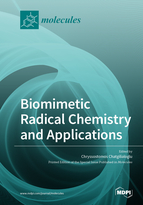Biomimetic Radical Chemistry and Applications
A special issue of Molecules (ISSN 1420-3049). This special issue belongs to the section "Bioorganic Chemistry".
Deadline for manuscript submissions: closed (30 September 2019) | Viewed by 74615
Special Issue Editor
Interests: free radical chemistry; biomimetic chemistry; organic synthesis; reaction mechanism; analytical protocols for biomarkers of radical stress; oxidative DNA damage; lipid modification; fatty acid-based lipidomics
Special Issues, Collections and Topics in MDPI journals
Special Issue Information
Dear Colleagues,
The enormous importance of free radical chemistry for a variety of biological events, including ageing and inflammation, has attracted a strong interest in understanding the related mechanistic steps at the molecular level. Modelling free radical chemical reactivity of biological systems is an important research area.
Some of the most interesting aspects of free radical chemistry that have emerged in the last two decades are radical enzyme mechanisms, cell signalling cascades, antioxidant activities, and free radical-induced damage of biomolecules. In addition, identification of modified biomolecules opened the way for the evaluation of in vivo damage through biomarkers.
This Special Issue covers aspects of free radical chemistry in biological events revealed using biomimetic chemical models. These include: catalytic pathways and mechanisms of radical enzymes, prebiotic chemistry, radical-induced DNA lesions or protein modifications, including analytical protocols, repair processes, biological consequences, lipid peroxidation and isomerization, defence systems based on antioxidants, as well as bio-inspired synthetic strategies.
Research articles and reviews related to these topics in biomimetic radical chemistry and applications are welcome.
Dr. Chryssostomos Chatgilialoglu
Guest Editor
Manuscript Submission Information
Manuscripts should be submitted online at www.mdpi.com by registering and logging in to this website. Once you are registered, click here to go to the submission form. Manuscripts can be submitted until the deadline. All submissions that pass pre-check are peer-reviewed. Accepted papers will be published continuously in the journal (as soon as accepted) and will be listed together on the special issue website. Research articles, review articles as well as short communications are invited. For planned papers, a title and short abstract (about 100 words) can be sent to the Editorial Office for announcement on this website.
Submitted manuscripts should not have been published previously, nor be under consideration for publication elsewhere (except conference proceedings papers). All manuscripts are thoroughly refereed through a single-blind peer-review process. A guide for authors and other relevant information for submission of manuscripts is available on the Instructions for Authors page. Molecules is an international peer-reviewed open access semimonthly journal published by MDPI.
Please visit the Instructions for Authors page before submitting a manuscript. The Article Processing Charge (APC) for publication in this open access journal is 2700 CHF (Swiss Francs). Submitted papers should be well formatted and use good English. Authors may use MDPI's English editing service prior to publication or during author revisions.
Keywords
- free radical
- biomimetic chemistry
- reactivity of biological systems
- reaction mechanisms
- biomarkers of radical stress
- reactive oxygen species
- biological damages
- antioxidants and repair mechanisms
- bio-inspired chemical synthesis and catalysis
Related Special Issue
- Biomimetic Radical Chemistry and Applications 2021 in Molecules (11 articles)







